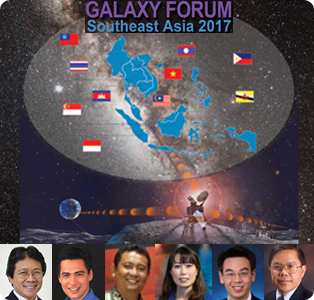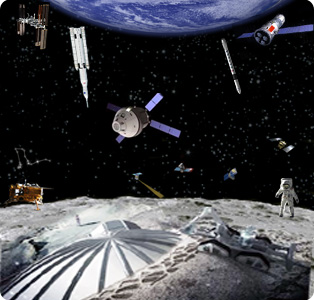ILOA Galaxy Forum East Asia Activities
International Lunar Observatory Association (ILOA) is hosting Galaxy Forum Southeast Asia – Indonesia themed Astronomy From The Moon with SkyWorld TMII in Jakarta February 18. Expecting 220 participants, the event features private space / aerospace, astronomy and related science / technology education and recreation. The Feb 25 Galaxy Forum Japan in Tokyo will be held at NAOJ Mitaka campus with theme Urban Challenges for Optical and Radio Astronomy. It features Astronaut Naoko Yamazaki, Sze-leung Cheung, Masao Saito, Hiroshi Kobayashi and Steve Durst. Galaxy Forum Southeast Asia – Singapore on Feb 23 will advance ILOA SEA Principal Operating Partnership for ILO-1 Moon mission via Multilateral Memorandum of Understanding (MMoU) signing with representatives from leading institutions of Singapore, Indonesia, Malaysia and Thailand, perhaps with future collaborations in Vietnam and Philippines. Galaxy Forum China in Beijing on June 5, the eve of GLEX 2017, will focus on pioneering Astronomy from the Moon and International Human Moon Missions, preliminary to Galaxy Forum Hainan in November for the launch of Chang’e-5 lunar sample return mission. ILOA is working with Canadensys of Canada and Moon Express of USA to design / build the ILO-1 Observatory intended for the Moon South Pole ~2018. ILO-X precursor mission is set to fly aboard the MX-1 lander to lunar equatorial region Dec 2017 via Rocket Lab Electron launch vehicle from New Zealand. (Image Credit: ILOA, NASA, Ma Chung University, SSTA, NARIT, IT Bandung, UKM) |
MONDAY Ongoing…
|

![]() = All times
= All times
for terrestrial events in local time unless noted.
![]() = All times for international terrestrial events in local time unless noted.
= All times for international terrestrial events in local time unless noted.
![]() = All times for space events, and…
= All times for space events, and…
![]() = All times for international space / astro events in Hawaii Standard Time unless noted. Add 10 hours to obtain UT (‘Universal Time;’ Greenwich, England).
= All times for international space / astro events in Hawaii Standard Time unless noted. Add 10 hours to obtain UT (‘Universal Time;’ Greenwich, England).
Weekly Planet Watch – Evening Planets: Venus (WSW), Mars (WSW), Jupiter (S), Uranus (SW); Morning Planets: Saturn (SE).
International Human Moon Mission Prospects 2020-2025 Depend on Crewed Lander Development
|
Continued from…
TUESDAY
|
WEDNESDAY
![]() Feb 22 — Roscosmos State Corporation, Launch Soyuz / Progress 66P, Baikonur Cosmodrome, Kazakhstan: Russia Soyuz rocket to launch Progress 66P resupply ship to ISS, arriving 2 days later.
Feb 22 — Roscosmos State Corporation, Launch Soyuz / Progress 66P, Baikonur Cosmodrome, Kazakhstan: Russia Soyuz rocket to launch Progress 66P resupply ship to ISS, arriving 2 days later.
![]() Feb 22 — UAE Space Agency, Lockheed Martin, Thales, SSL, et al, Abu Dhabi, United Arab Emirates: MilSatCom Middle East 2017 Conference.
Feb 22 — UAE Space Agency, Lockheed Martin, Thales, SSL, et al, Abu Dhabi, United Arab Emirates: MilSatCom Middle East 2017 Conference.
![]() Feb 22-23 — Mars Exploration Program Analysis Group, NASA, Monrovia CA: 33rd Mars Exploration Program Analysis Group (MEPAG).
Feb 22-23 — Mars Exploration Program Analysis Group, NASA, Monrovia CA: 33rd Mars Exploration Program Analysis Group (MEPAG).
![]() Feb 22-24 — Singapore Space and Technology Association, National University of Singapore, Defense Science and Technology Agency, et al, Singapore: Global Space & Technology Convention 2017.
Feb 22-24 — Singapore Space and Technology Association, National University of Singapore, Defense Science and Technology Agency, et al, Singapore: Global Space & Technology Convention 2017.
![]() Feb 22-24 — University of Edinburgh Astrobiology Society, Edinburgh, United Kingdom: Manifest Destiny: An Interdisciplinary Forum on Mars Colonization.
Feb 22-24 — University of Edinburgh Astrobiology Society, Edinburgh, United Kingdom: Manifest Destiny: An Interdisciplinary Forum on Mars Colonization.
![]() Feb 22-25 — Emirates Mars Mission, Mohammed Bin Rashid Space Center (MBRSC), American Physical Society (APS), Materials Research Society (MRS), Sharjah, United Arab Emirates: Frontiers in Theoretical and Applied Physics – UAE 2017 (FTAPS 2017); at American University of Sharjah.
Feb 22-25 — Emirates Mars Mission, Mohammed Bin Rashid Space Center (MBRSC), American Physical Society (APS), Materials Research Society (MRS), Sharjah, United Arab Emirates: Frontiers in Theoretical and Applied Physics – UAE 2017 (FTAPS 2017); at American University of Sharjah.
![]() Feb 22 — Apollo Asteroid 2016 CO246: Near-Earth Flyby (0.039 AU).
Feb 22 — Apollo Asteroid 2016 CO246: Near-Earth Flyby (0.039 AU).
THURSDAY
![]() Feb 23 — International Lunar Observatory Association, Space Age Publishing Company, Singapore: Galaxy Forum Southeast Asia 2017 – Singapore: ILOA SEA Principal Operating Partnership; at Singapore Marriott.
Feb 23 — International Lunar Observatory Association, Space Age Publishing Company, Singapore: Galaxy Forum Southeast Asia 2017 – Singapore: ILOA SEA Principal Operating Partnership; at Singapore Marriott.
![]() Feb 23 — Cornell University, Ithaca NY: Lecture: Cosmology with Shadows in the Microwave Sky; Nicholas Battaglia – Princeton University, 16:00.
Feb 23 — Cornell University, Ithaca NY: Lecture: Cosmology with Shadows in the Microwave Sky; Nicholas Battaglia – Princeton University, 16:00.
![]() Feb 23 — Apollo Asteroid 2017 BY93: Near-Earth Flyby (0.006 AU).
Feb 23 — Apollo Asteroid 2017 BY93: Near-Earth Flyby (0.006 AU).
FRIDAY
![]() Feb 24 — ISS, Progress 66P Rendezvous and Docking, LEO: Russia Progress 66P resupply ship to arrive at ISS today and dock autonomously, 03:34 ET, live coverage available.
Feb 24 — ISS, Progress 66P Rendezvous and Docking, LEO: Russia Progress 66P resupply ship to arrive at ISS today and dock autonomously, 03:34 ET, live coverage available.
![]() Feb 24 — Challenger Center, Aerojet Rocketdyne, Sacramento CA: Rendezvous with Comet Halley; simulated space mission supporting astronauts from Mission Control and hands-on science experiments, robotics, space probe development.
Feb 24 — Challenger Center, Aerojet Rocketdyne, Sacramento CA: Rendezvous with Comet Halley; simulated space mission supporting astronauts from Mission Control and hands-on science experiments, robotics, space probe development.
![]() Feb 24 — Rob and Terry Ryan Foundation, W. M. Keck Observatory, Honoka’a HI: Cosmic Events: Fingerprints of the first stars: Searching for Population III with Keck; John O’Meara from Saint Michael’s College, at Honoka`a People’s Theatre, 19:00.
Feb 24 — Rob and Terry Ryan Foundation, W. M. Keck Observatory, Honoka’a HI: Cosmic Events: Fingerprints of the first stars: Searching for Population III with Keck; John O’Meara from Saint Michael’s College, at Honoka`a People’s Theatre, 19:00.
![]() Feb 24 — Planetary and Terrestrial Mining Sciences Symposium, Space Resources Roundtable, Online / Montreal, Quebec, Canada: Abstracts Due: 8th PTMSS / SRR; being held May 1-3.
Feb 24 — Planetary and Terrestrial Mining Sciences Symposium, Space Resources Roundtable, Online / Montreal, Quebec, Canada: Abstracts Due: 8th PTMSS / SRR; being held May 1-3.
![]() Feb 24 — Apollo Asteroid 2017 CP1: Near-Earth Flyby (0.009 AU).
Feb 24 — Apollo Asteroid 2017 CP1: Near-Earth Flyby (0.009 AU).
![]() Feb 24 — Aten Asteroid 5604 (1992 FE): Near-Earth Flyby (0.034 AU).
Feb 24 — Aten Asteroid 5604 (1992 FE): Near-Earth Flyby (0.034 AU).
![]() Feb 24 — Amor Asteroid 2017 BN3: Near-Earth Flyby (0.065 AU).
Feb 24 — Amor Asteroid 2017 BN3: Near-Earth Flyby (0.065 AU).
SATURDAY
![]() Feb 25 — International Lunar Observatory Association, National Astronomical Observatory Japan, Space Age Publishing Company, Mitaka, Tokyo, Japan: Galaxy Forum Japan 2017 – Mitaka: Urban Challenges for Optical and Radio Astronomy; at NAOJ.
Feb 25 — International Lunar Observatory Association, National Astronomical Observatory Japan, Space Age Publishing Company, Mitaka, Tokyo, Japan: Galaxy Forum Japan 2017 – Mitaka: Urban Challenges for Optical and Radio Astronomy; at NAOJ.
![]() Feb 25 — Smithsonian National Air and Space Museum, Washington DC: Event: African-American Pioneers in Aviation and Space.
Feb 25 — Smithsonian National Air and Space Museum, Washington DC: Event: African-American Pioneers in Aviation and Space.
![]() Feb 25 — Sally Ride Science, UC San Diego, San Diego CA: Educator’s Event: Engaging Students in Learning About Earth’s Climate.
Feb 25 — Sally Ride Science, UC San Diego, San Diego CA: Educator’s Event: Engaging Students in Learning About Earth’s Climate.
![]() Feb 25 — Apollo Asteroid 2005 QB5: Near-Earth Flyby (0.093 AU).
Feb 25 — Apollo Asteroid 2005 QB5: Near-Earth Flyby (0.093 AU).
SUNDAY
![]() Feb 26 — Annular Solar Eclipse: Moon appears smaller than Sun as it passes centrally across solar disk and a bright ring (annulus) of sunlight remains visible during the eclipse; main phase will be visible along a narrow path stretching from southern tip of South America to Angola in Africa; Maximum Eclipse, 04:53.
Feb 26 — Annular Solar Eclipse: Moon appears smaller than Sun as it passes centrally across solar disk and a bright ring (annulus) of sunlight remains visible during the eclipse; main phase will be visible along a narrow path stretching from southern tip of South America to Angola in Africa; Maximum Eclipse, 04:53.
![]() Feb 26 — Moon: New Moon, 04:58.
Feb 26 — Moon: New Moon, 04:58.
![]() Feb 26 — Apollo Asteroid 2016 FU12: Near-Earth Flyby (0.042 AU).
Feb 26 — Apollo Asteroid 2016 FU12: Near-Earth Flyby (0.042 AU).
![]() Feb 26 — Apollo Asteroid 2014 HP4: Near-Earth Flyby (0.073 AU).
Feb 26 — Apollo Asteroid 2014 HP4: Near-Earth Flyby (0.073 AU).

 The tides of global Space Age activity are shifting back toward lunar surface enterprise and development as critical next step in human progress. NASA and its industry partners, along with participation from ESA, are considering feasibility of accelerating pace for human lunar flight by adapting Exploration Mission-1 (EM1) with in-development SLS heavy launch rocket and Orion crew spacecraft from automated circumlunar test flight to crewed flight in 2018 (current first crewed flight is EM2 in 2021). Critical piece of missing architecture is crewed lunar lander system. China would appear to be the leader in terms of contemporary Moon landing capability and potential near-term advancement with the Chang’e-5 (CE-5) and CE-6 sample return missions set to launch this year November 2017 and 2020 respectively aboard the newly-commissioned Long March 5 heavy-lift rocket system. With next-gen super-heavy Long March 9 rocket expected 2025, as well as steady progress on its Shenzhou human spaceflight, Tiangong space laboratory and CE lunar programs, a convergence leading to crewed lunar surface missions is expected soon rather than later. Also advancing relevant Moon services and systems are an array of multifarious American independent ventures from Blue Origin with the New Glenn / New Armstrong series and SpaceX with the upcoming Falcon Heavy, to Bigelow, Golden Spike, Astrobotic, Moon Express, Shackleton Energy, Canadensys and ILOA. (Image Credit: NASA, ESA, CNSA, CAS/NAOC, SpaceX)
The tides of global Space Age activity are shifting back toward lunar surface enterprise and development as critical next step in human progress. NASA and its industry partners, along with participation from ESA, are considering feasibility of accelerating pace for human lunar flight by adapting Exploration Mission-1 (EM1) with in-development SLS heavy launch rocket and Orion crew spacecraft from automated circumlunar test flight to crewed flight in 2018 (current first crewed flight is EM2 in 2021). Critical piece of missing architecture is crewed lunar lander system. China would appear to be the leader in terms of contemporary Moon landing capability and potential near-term advancement with the Chang’e-5 (CE-5) and CE-6 sample return missions set to launch this year November 2017 and 2020 respectively aboard the newly-commissioned Long March 5 heavy-lift rocket system. With next-gen super-heavy Long March 9 rocket expected 2025, as well as steady progress on its Shenzhou human spaceflight, Tiangong space laboratory and CE lunar programs, a convergence leading to crewed lunar surface missions is expected soon rather than later. Also advancing relevant Moon services and systems are an array of multifarious American independent ventures from Blue Origin with the New Glenn / New Armstrong series and SpaceX with the upcoming Falcon Heavy, to Bigelow, Golden Spike, Astrobotic, Moon Express, Shackleton Energy, Canadensys and ILOA. (Image Credit: NASA, ESA, CNSA, CAS/NAOC, SpaceX)